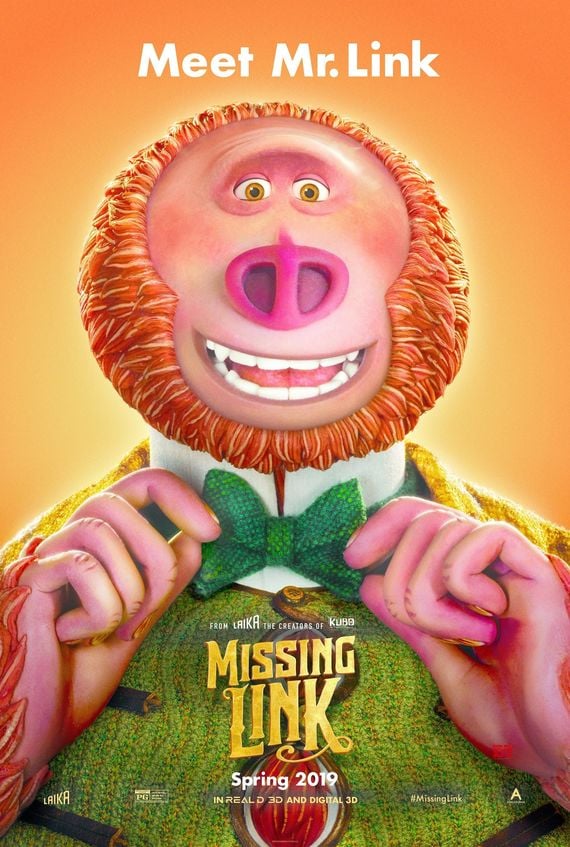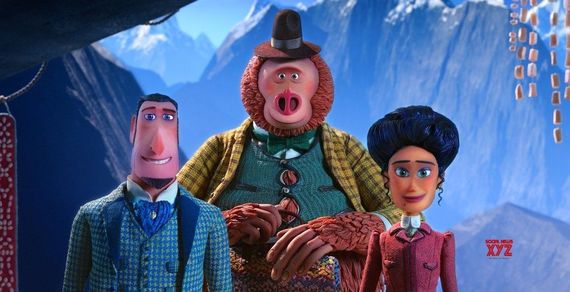Is the new kid's film "Missing Link" really trafficking in 19th-century anti-Irish stereotypes?
Irish historians taking the subway through New York this week could have been forgiven if their jaws dropped at the sight of a film poster announcing the new animated feature "Missing Link" from Laika studios.
The poster, which introduces us to the film's central character Mr. Link, bluntly looks like a 19th-century simian featured a caricature of a red-haired half-ape half-human Irishman, of the kind one popularized by notorious anti-Irish bigot Thomas Nast.
Read more: Irish Famine movie "Black 47" now available on Netflix in Ireland

Are Irish men the Missing Link?
With his copper locks, green bow tie and a bursting green waistcoat set off by a jaunty leprechaun style cap, the image is a dead ringer for the kind of caricatures of the Irish popularized by nativists in the 19th century in the United States and Britain.
In fact, some observers are saying that the parallels with old-time racist caricatures are so on the nose that they must have been, at some level, intentional.
And if not, an awful lot of symbols would have had to cohere accidentally to create this unintentionally offensive 19th-century-looking character (when the film is set) in the 21st century.

Are Irish men the Missing Link?
And is it not significant that the two upper-class people who are advocating for Mr. Link's humanity throughout the film are English? Did no one involved with the whole process think "Er, lads? Hang on a sec?"
“My students are stunned that there was any kind of debate about the humanity of the Irish in the 19th century,” says Professor Michael De Nie, who teaches courses on Britain, Ireland, Europe in the 19th Century at the University of West Georgia.
“I have shown them the cartoons of the Irish, those famous caricatures with Simian featured eyes and brows. The point of those images was to make them seem subhuman. The message back then was that they're brutal and in need of governing.”
Read more: A must-watch Netflix documentary on Miami Showband massacre

Are Irish men the Missing Link?
In fact, there was a time in the 19th century when people were literally positing that the Irish themselves were the missing link and that fact always elicits shock or surprise and sometimes laughter from his students, De Nie says.
“It just seems ludicrous to them. If the poster for this film was printed in New York or Boston or Chicago at the turn of the 20th century, I think some people would've picked up on it and some might have seen the character as suggestively Irish.
“But I think that response is far out of our own time now. I would bet that the people who wrote and performed this film didn't really have any awareness of that history.”

Are Irish men the Missing Link?
“I think that these images have a long tail and perhaps can become a subconscious cultural inheritance in a way," Professor De Nie added.
"The ones in this film could arise from images that the creators saw when they were children or younger. It just seems hard to believe that it was a conscious thing because the film is about making money. And making money means you have to appeal to the widest possible audience.”
But doesn't it seem like a lot of coincidences had to happen simultaneously to come up with such a potent image and it not be a caricature?
The missing link, the half-ape half-human character, the little green tie and the ill-fitting blazer and the red hair and the simian features? And the English guides to show him the path to his future? That's a hell of a lot of coincidences, is it not?
De Nie responds: “It certainly was a little blind of the people or whoever approved it. I've seen that they have dressed the English characters like our idea of a late Victorian gentleman. They have also dressed Mr. Link like a lower class guy, down to the hat and waist coast, which, of course, we associate with the working class Irish of the period.
"But I would be very hesitant to ascribe deliberates intentions here. I just think it's fascinating the way the long tail of these things that some of the images and the combinations can travel through time and even when divorced of their original intent.
“They just get defanged over time in a way. The images of certain groups can remain longer than the negative attitudes to the groups themselves. So I'm saying that even though it looks like certain images from the past we don't immediately associate it with negative things anymore.”
What are your thoughts? Let us know in the comments section, below.




Comments